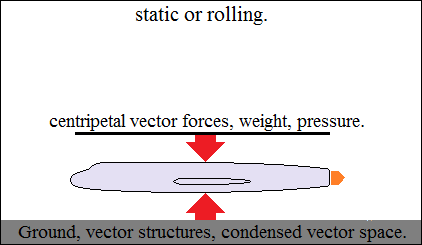The plane's flight.
Considering that the fundamental form of nature's existence is the
interactions of vector properties, that is, energy, vector physics differs
completely from materialist physics. All material forms are structures
of
vector interactions, energy. The forces of attraction in orthogonally
closed
vector circuits (electromagnetic), generate centripetal forces and mutually
compress the density of vector space, becoming a tiny, solid and cold
point,
called hydrogen. Hydrogen is not an atom, it is a vector space structure,
with enormous density, called pressure. Hydrogen is potential energy,
produced by the density of vector space and the lack of vector oscillations.
Therefore, hydrogen is a high-density vector space, integrated into the
vector space, through the extensions of the open vector polarities.
The vector space, with the extensions of the open polarities of the set
of
hydrogen structures, forms orthogonally closed macroscopic vector circuits,
called stars. The dimensions of macroscopic vector structures are variable,
depending on the amount of hydrogen in the vector space contained in the
orthogonal circuits. The centripetal vector forces exponentially raise
the
density of the vector space and of the hydrogen contained in the orthogonal
circuits towards the center. In this way, concentric layers of hydrogen
are
formed, with the intensity of the reactions depending on the density of
the
vector space, known in the case of the sun. The main phenomenon is the
reproduction in the activity of stars of macroscopic vector circuits closed
orthogonally, forming planetary, stellar and galactic systems. In the
case of
planets, due to the small size of the orthogonally closed vector circuits,
the
reactions of hydrogen in the concentric layers, depending on the density,
were predominantly their vector bonds, forming elements.
Due to the abundance of elements, planets tend towards a solid, cold structure.
This is the case of planet Earth, covered by oceans and solid continents,
with plant and animal organisms. From here we understand the property
of
vector space, to generate vector structures, from simple to complex, the
complex being reason and thought still unknown. As a conclusion, we can
understand what a brake the materialistic conception was and is for the
knowledge of nature. Now we can talk about the flight of the airplane,
a
man-made device, as reality shows. The density of vector space in the
earth's atmosphere is also composed of the density of vector structures,
molecules of nitrogen, oxygen, carbon, etc. Each of these structures has
positive and negative vector polarities open in vector space, constituting
the
reinforcement of vector space, like reinforced concrete. The speedy
movement of the airplane, also formed by elements, vector structures,
orients
the vector polarities of the vector space and of the contained structures,
in
the direction and sense of movement. The orientations of the vector polarities
being parallel, their repulsive forces become a support, a guide for the
movement of the airplane. The same forces define the inertial motion and
the rotational motion of the gyroscope. Support vector forces are also
those
of the solid vector structures on which the airplane runs (runway) or
parks.

